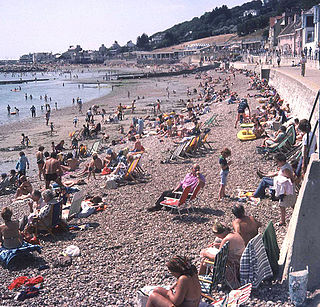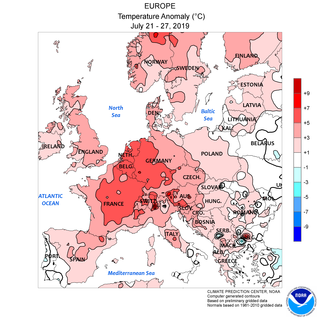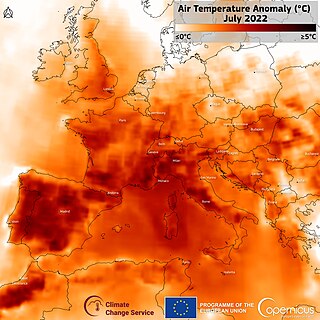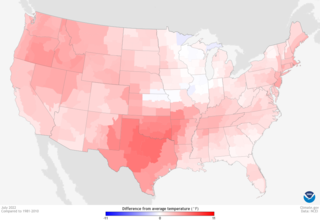| Areas | British Isles |
|---|---|
| Start date | 15 July 2021 |
| End date | 25 July 2021 |
| Peak temp. | 32.2 °C (90.0 °F), recordedat Heathrow Airport, London on 21 July 2021 |
The 2021 Britain and Ireland heat wave was a period of unusually hot weather in July 2021 that led to record-breaking temperatures in the UK and Ireland.
On 19 July, the Met Office issued its first ever extreme heat warning for parts of the UK. [1] [2] Temperatures soared across the United Kingdom over a weekend which saw all four nations record the hottest day of the year. [3] [4] On 17 July, temperatures reached 31.2 °C (88.2 °F) in County Down, Northern Ireland. [5] On 18 July, temperatures reached 31.6 °C (88.9 °F) at Heathrow Airport, London and 30.2 °C (86.4 °F) in Cardiff, Wales. [6] [7]
In the Republic of Ireland, Met Éireann issued its first ever Status Orange high temperature warning for six counties on 20 July, [8] after temperatures reached 29.5 °C (85.1 °F) in Athenry, County Galway on 17 July. [9]
On 21 July, temperatures reached 32.2 °C (90.0 °F) at Heathrow, London. [10] In Ireland, temperatures reached 30.8 °C (87.4 °F) at Mount Dillon, County Roscommon. In Northern Ireland a new record for maximum temperature was set, with 31.3 °C (88.3 °F) was reached at Castlederg, County Tyrone. [11]
Despite the extreme weather warning, the 2021 July heatwave was relatively mild in comparison to heatwaves in the UK and Ireland of previous and subsequent years, with heatwaves in previous years surpassing the maximum temperature of this heatwave, particularly in the south east. [12] [13] [14]

The 2003 European heat wave saw the hottest summer recorded in Europe since at least 1540. France was hit especially hard. The heat wave led to health crises in several countries and combined with drought to create a crop shortfall in parts of Southern Europe. The death toll has been estimated at more than 70,000.

A period of unusually hot summer weather occurred in the British Isles during the summer of 1976. At the same time, there was a severe drought on the islands of Great Britain and Ireland. It was one of the driest, sunniest and warmest summers (June/July/August) in the 20th century, although the summer of 1995 is now regarded as the driest. Only a few places registered more than half their average summer rainfall. In the Central England temperature record, it was the warmest summer in the series until being surpassed in the 21st century. It was the warmest summer in the Aberdeen area since at least 1864, and the driest summer since 1868 in Glasgow.

The 2006 European heat wave was a period of exceptionally hot weather that arrived at the end of June 2006 in certain European countries. The United Kingdom, France, Belgium, the Netherlands, Luxembourg, Italy, Poland, the Czech Republic, Hungary, Germany and western parts of Russia were most affected.
The 1906 British Isles heatwave occurred across the British Isles in August and September 1906. The heat wave had a comparable intensity to the 1990 heat wave. From 31 August to 3 September, the temperature in the UK exceeded 32 °C (90 °F) consecutively over much of the UK. In September, Central England and Birmingham recorded a maximum temperature of 31.5 °C (88.7 °F), while Oxford recorded a maximum temperature of 33.1 °C (91.6 °F).

The 2010 Northern Hemisphere summer heat waves included severe heat waves that impacted most of the United States, Kazakhstan, Mongolia, China, Hong Kong, North Africa and the European continent as a whole, along with parts of Canada, Russia, Indochina, South Korea and Japan during July 29, 2010. The first phase of the global heatwaves was caused by a moderate El Niño event, which lasted from June 2009 to May 2010. This lasted only from April 2010 to June 2010 and caused only moderate above-average temperatures in the affected regions, but it also set new record high temperatures for most of the area affected in the Northern Hemisphere.

The 2013 extreme weather events included several all-time temperature records in Northern and Southern Hemisphere. The February extent of snow cover in Eurasia and North America was above average, while the extent of Arctic ice in the same month was 4.5% below the 1981–2010 average. The Northern Hemisphere weather extremes have been linked to the melting of Arctic sea ice, which alters atmospheric circulation in a way that leads to more snow and ice.
The 2013 heatwave in the United Kingdom and Ireland was a period of unusually hot weather primarily in July 2013, with isolated warm days in June and August. A prolonged high pressure system over Great Britain and Ireland caused higher than average temperatures for 19 consecutive days in July, reaching 33.5 °C (92.3 °F) at Heathrow and Northolt.

The 1995 British Isles heatwave occurred between late July and late August. It was part of one of the warmest summers recorded in the UK, and one of the warmest Augusts ever recorded in many locations around the UK, as well as being one of the driest summers ever recorded in the UK; many weather stations recorded the summer of 1995 as drier than, or comparable with, the summer of 1976. Ireland was also widely affected by the heatwave with temperatures reaching over 30 °C (86 °F) in some locations, as well as exceptionally low rainfall throughout the summer.

The 2018 Britain and Ireland heatwave was a period of unusually hot weather that took place in June, July and August. It caused widespread drought, hosepipe bans, crop failures, and a number of wildfires. These wildfires worst affected northern moorland areas around the Greater Manchester region, the largest was at Saddleworth Moor and another was at Winter Hill, together these burned over 14 square miles (36 km2) of land over a period of nearly a month.

In late June and late July 2019 there were two temporally distinct European heat waves, which set all-time high temperature records in Belgium, France, Germany, Luxembourg, the Netherlands, and the United Kingdom.

Across Europe and parts of Asia, unusually high-temperatures in the late-winter period were reported from February 20 until February 28, 2021. The onset of the short-lasting winter heat wave was caused by a jet stream of Saharan dust. Daily high temperatures for the period were similar to the maximum high temperatures during spring.

The 2021 Western North America heat wave was an extreme heat wave that affected much of Western North America from late June through mid-July 2021. The heat wave affected Northern California, Idaho, Western Nevada, Oregon, and Washington in the United States, as well as British Columbia, and in its latter phase, Alberta, Manitoba, the Northwest Territories, Saskatchewan, and Yukon, all in Canada. It also affected inland regions of Central and Southern California, Nevada, and Montana, though the temperature anomalies were not as extreme as in the regions farther north.

In 2022, several areas of the world experienced heat waves. Heat waves were especially notable in East Asia, the Indian subcontinent, Australia, western Europe, the United States, and southern South America. 2022 heat waves accounted for record-breaking temperatures and, in some regions, heat-related deaths. Heat waves were worsened by the effects of climate change, and they exacerbated droughts and wildfires.

The 2022 United Kingdom heatwaves were part of several heatwaves across Europe and North Africa. The United Kingdom experienced three heatwaves; the first was for three days in June, the second for three days in July, and the third for six days in August. Climatologists say the extreme heat was due to climate change. 2022 was the UK's warmest year since records began in 1884, with an average annual temperature above 10 °C (50 °F) for the first time. The 2022 heatwaves contributed to the death of nearly 3000 people, most of whom were 65 years or older.

From June to August 2022, persistent heatwaves affected parts of Europe, causing evacuations and killing tens of thousands. These heat waves were the deadliest meteorological events in 2022. The highest temperature recorded was 47.0 °C (116.6 °F) in Pinhão, Portugal, on 14 July.

From late spring to late summer heat waves in 2022 smashed many records in North America between May and September of that year. Dozens of temperature records were surpassed in the United States.

A number of heat waves began across parts of the northern hemisphere in April 2023, many of which are ongoing. Various heat records have been broken, with July being the hottest month ever recorded.

In 2023, Europe had been affected by heat waves. The most significant of which was the named heat wave, Cerberus Heatwave, which brought the hottest temperatures ever recorded in Europe. Starting on 10 July 2023, the record-breaking Cerberus anticyclone affected many European countries, with the effects felt most severely in parts of Southeast and Southwest Europe such as Cyprus, Greece, Italy, and Spain. The private Italian weather website iLMeteo named the extreme weather event after the hound of Hades from Greek mythology, and although some reports link the naming to the Italian Meteorological Society, the society's president said that they "absolutely don't use it".
Europe has been affected by heat waves since June 2024, breaking several regional temperature records across multiple nations in Southern and Southeast Europe.